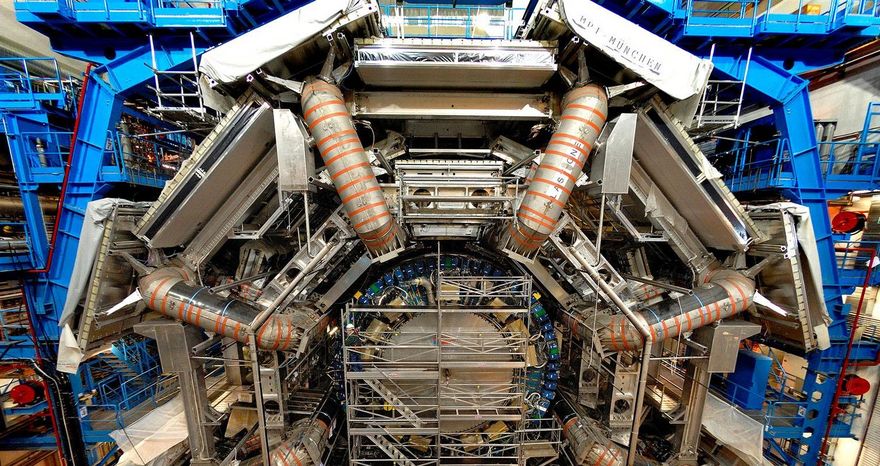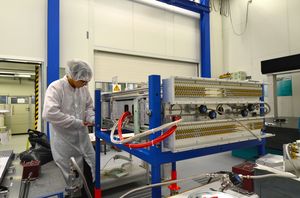Muons are a type of particle related to electrons. They arise out of the decay of particles produced by the collision of protons in the center of the ATLAS detector. The muons' signals enable inferences about which particles came out of the impact of the protons.
For that, the scientists use the muon spectrometer. It is the outermost part of the ATLAS detector and measures the energy and trajectory of the muons with high accuracy. To this end, the particles are deflected in a strong magnetic field, which is generated by gigantic superconducting magnetic coils. Through precise analysis of muon tracks, among other data, the scientists were able to discover the long-sought Higgs boson.
In order to measure the muon tracks, the physicists use so-called muon drift tube chambers (MDT). These consist of several layers of drift tubes, which are filled with a gas mixture of argon and carbon dioxide. Through reactions with the argon atoms, the muons leave behind tracks in the drift tubes. By means of a high voltage of around 3,000 volts between the tube wall and a central counting wire, these tracks are registered and converted into electronic signals.
The muon spectrometer is also responsible for the enormous size of the ATLAS detector: With around 1,150 MDT chambers and more than 350,000 drift tubes, it measures the paths of the muons that pass through – over a total area the size of a footbal field, to an accuracy of less than one-hundredth of a millimeter. The chambers were developed at the Institute and were in large part constructed there. All of the chambers were installed in the underground ATLAS hall in 2005 and 2006.
Muon chambers for the future
The discovery of the Higgs boson was a major step for particle physics. Yet the physicists involved with the ATLAS experiment want the particle collisions to coax out further exciting insights. For that, they need more data, and therefore more collisions of protons.
In the coming years, the LHC will be upgraded to meet that need. At the updated High Luminosity (HL)-LHC, not long from how, significantly more proton packets than before will be accelerated and brought to collision. Due to the higher irradiation, the components of the ATLAS detector must also be upgraded. The MPP is currently developing a new, improved design for the muon chambers as well as new electronic components.
More information on the ATLAS muon system group
Group members
E-mail address: e-mail@mpp.mpg.de
Phone number: +49 89 32354-extension
name
function
e-mail
extension
office
Bethke, Siegfried, Prof. Dr.
Emeritus
siegfried.bethke
381
A.2.05
Buchin, Daniel
PhD Student
daniel.buchin
376
A.2.21
Cieri, Davide, Dr.
Senior Scientist
davide.cieri
226
A.2.10
Costa, Davide
Student
davide.costa
503
A.2.15
Cuppini, Elena
PhD Student
elena.cuppini
376
A.2.21
Fallavollita, Francesco, Ph.D.
Postdoc
francesco.fallavollita
256
A.3.01
Grewe, Simon
PhD Student
simon.grewe
358
A.2.19
Kado, Marumi, Prof. Dr.
Director
marumi.kado
382
A.2.45
Kortner, Oliver, PD Dr.
Senior Scientist
oliver.kortner
240
A.2.12
Kortner, Sandra, Dr.
Senior Scientist
sandra.kortner
288
A.2.14
Kroha, Hubert, Prof. Dr.
Senior Scientist
hubert.kroha
435
A.2.29
Kube, Nick
Student
nick.kube
503
A.2.15
Lautier, Remi
Student
remi.lautier
559
A.3.01
Lohrmann, Max Emanuel
Student
max.lohrmann
559
A.2.23
Maly, Pavel, Ph.D.
Engineering
pavel.maly
385
B.2.FL2
Meier, Nick
Student
nick.meier
503
A.2.15
Okfen, Julia
Student
julia.okfen
503
A.2.15
Proto, Giorgia, Dr.
Postdoc
giorgia.proto
559
A.3.01
Resende, Francisco
Student
francisco.resende
559
A.2.23
Richter, Robert, Dr.
Senior Scientist
robert.richter
258
A.1.15
Schielke, Anja
Secretary
anja.schielke
299
A.2.47
Schäfer, Tim
Student
tim.schafer
376
A.2.21
Soyk, Daniel
Engineering
daniel.soyk
374
B.2.FL2
Voevodina, Elena, Dr.
Postdoc
elena.voevodina
559
A.2.23
Weber, David
Student
david.weber
299
A.2.15
Wesely, Bastian
Student
bastian.wesely
503
A.2.15
Zhou, Fan
Student
fan.zhou
503
A.2.15
Zimmermann, Jörg
Engineering
joerg.zimmermann
446
B.2.35
Group members
Phone number: +49 89 32354-extension
| name | function | extension | office | |
|---|---|---|---|---|
| Bethke, Siegfried, Prof. Dr. | Emeritus | siegfried.bethke | 381 | A.2.05 |
| Buchin, Daniel | PhD Student | daniel.buchin | 376 | A.2.21 |
| Cieri, Davide, Dr. | Senior Scientist | davide.cieri | 226 | A.2.10 |
| Costa, Davide | Student | davide.costa | 503 | A.2.15 |
| Cuppini, Elena | PhD Student | elena.cuppini | 376 | A.2.21 |
| Fallavollita, Francesco, Ph.D. | Postdoc | francesco.fallavollita | 256 | A.3.01 |
| Grewe, Simon | PhD Student | simon.grewe | 358 | A.2.19 |
| Kado, Marumi, Prof. Dr. | Director | marumi.kado | 382 | A.2.45 |
| Kortner, Oliver, PD Dr. | Senior Scientist | oliver.kortner | 240 | A.2.12 |
| Kortner, Sandra, Dr. | Senior Scientist | sandra.kortner | 288 | A.2.14 |
| Kroha, Hubert, Prof. Dr. | Senior Scientist | hubert.kroha | 435 | A.2.29 |
| Kube, Nick | Student | nick.kube | 503 | A.2.15 |
| Lautier, Remi | Student | remi.lautier | 559 | A.3.01 |
| Lohrmann, Max Emanuel | Student | max.lohrmann | 559 | A.2.23 |
| Maly, Pavel, Ph.D. | Engineering | pavel.maly | 385 | B.2.FL2 |
| Meier, Nick | Student | nick.meier | 503 | A.2.15 |
| Okfen, Julia | Student | julia.okfen | 503 | A.2.15 |
| Proto, Giorgia, Dr. | Postdoc | giorgia.proto | 559 | A.3.01 |
| Resende, Francisco | Student | francisco.resende | 559 | A.2.23 |
| Richter, Robert, Dr. | Senior Scientist | robert.richter | 258 | A.1.15 |
| Schielke, Anja | Secretary | anja.schielke | 299 | A.2.47 |
| Schäfer, Tim | Student | tim.schafer | 376 | A.2.21 |
| Soyk, Daniel | Engineering | daniel.soyk | 374 | B.2.FL2 |
| Voevodina, Elena, Dr. | Postdoc | elena.voevodina | 559 | A.2.23 |
| Weber, David | Student | david.weber | 299 | A.2.15 |
| Wesely, Bastian | Student | bastian.wesely | 503 | A.2.15 |
| Zhou, Fan | Student | fan.zhou | 503 | A.2.15 |
| Zimmermann, Jörg | Engineering | joerg.zimmermann | 446 | B.2.35 |
Key publications
F. Bauer, W. Blum, U. Bratzler, H. Dietl, S. Kotov, H. Kroha, Th. Lagouri, A. Manz, A. Ostapchuk, R. Richter, S. Schael, S. Chouridou, M. Deile, O. Kortner, A. Staude, R. Stroehmer, T. Trefzger
Construction and Test of the Precision Drift Chambers for the ATLAS Muon Spectrometer
MPI-PhE/2000-29, October 2000, IEEE Transactions on Nuclear Science, Vol. 48, No. 3 (2001) 302
arXiv:1604.02259
DOI: 10.1109/23.940070
M. Deile, J. Dubbert, S. Horvat, O. Kortner, H. Kroha, A. Manz, S. Mohrdieck-Moeck,
F. Rauscher, R. Richter, A. Staude, W. Stiller
Resolution and Efficiency of the ATLAS Muon Drift-Tube Chambers at High Background Rates,
MPP-2004-042, April 2004
Nuclear Instruments and Methods A 535 (2004) 212
arXiv:1603.09572
DOI: 10.1016/j.nima.2004.07.193
B. Bittner, J. Dubbert, O. Kortner, H. Kroha, F. Legger, R. Richter,
O. Biebel, A. Engl, R. Hertenberger, F. Rauscher,
Development of Muon Drift-Tube Detectors for High-Luminosity Upgrades of the Large Hadron Collider,
MPP-2009-321, June 2009,
Nuclear Instruments and Methods A 617 (2010) 169
arXiv:1603.09504
DOI: 10.1016/j.nima.2009.06.086
H. Kroha, B. Bittner, J. Dubbert, O. Kortner, A. Manfredini, S. Ott, R. Richter, P. Schwegler, D. Zanzi,
O. Biebel, A. Engl, R. Hertenberger, A. Zibell
Construction and Test of a Full Prototype Drift-Tube Chamber for the Upgrade of the ATLAS Muon Spectrometer at High LHC Luminosities
MPP-2012-161, August 2012
Nuclear Instruments and Methods A 718 (2013) 427.
P. Schwegler, O. Kortner, H. Kroha, R. Richter
Improvement of the L1 Trigger for the ATLAS Muon Spectrometer at High Luminosity
MPP-2012-161, August 2012
Nuclear Instruments and Methods A 718 (2013) 245.
C. Ferretti, H. Kroha,
Upgrades of the ATLAS Muon Spectrometer With sMDT Chambers
MPI report, MPP-2015-136, June 2015
Nuclear Instruments and Methods A 824 (2016) 538
arXiv:1603.09544
Key publications
F. Bauer, W. Blum, U. Bratzler, H. Dietl, S. Kotov, H. Kroha, Th. Lagouri, A. Manz, A. Ostapchuk, R. Richter, S. Schael, S. Chouridou, M. Deile, O. Kortner, A. Staude, R. Stroehmer, T. Trefzger
Construction and Test of the Precision Drift Chambers for the ATLAS Muon Spectrometer
MPI-PhE/2000-29, October 2000, IEEE Transactions on Nuclear Science, Vol. 48, No. 3 (2001) 302
arXiv:1604.02259
DOI: 10.1109/23.940070
M. Deile, J. Dubbert, S. Horvat, O. Kortner, H. Kroha, A. Manz, S. Mohrdieck-Moeck,
F. Rauscher, R. Richter, A. Staude, W. Stiller
Resolution and Efficiency of the ATLAS Muon Drift-Tube Chambers at High Background Rates,
MPP-2004-042, April 2004
Nuclear Instruments and Methods A 535 (2004) 212
arXiv:1603.09572
DOI: 10.1016/j.nima.2004.07.193
B. Bittner, J. Dubbert, O. Kortner, H. Kroha, F. Legger, R. Richter,
O. Biebel, A. Engl, R. Hertenberger, F. Rauscher,
Development of Muon Drift-Tube Detectors for High-Luminosity Upgrades of the Large Hadron Collider,
MPP-2009-321, June 2009,
Nuclear Instruments and Methods A 617 (2010) 169
arXiv:1603.09504
DOI: 10.1016/j.nima.2009.06.086
H. Kroha, B. Bittner, J. Dubbert, O. Kortner, A. Manfredini, S. Ott, R. Richter, P. Schwegler, D. Zanzi,
O. Biebel, A. Engl, R. Hertenberger, A. Zibell
Construction and Test of a Full Prototype Drift-Tube Chamber for the Upgrade of the ATLAS Muon Spectrometer at High LHC Luminosities
MPP-2012-161, August 2012
Nuclear Instruments and Methods A 718 (2013) 427.
P. Schwegler, O. Kortner, H. Kroha, R. Richter
Improvement of the L1 Trigger for the ATLAS Muon Spectrometer at High Luminosity
MPP-2012-161, August 2012
Nuclear Instruments and Methods A 718 (2013) 245.
C. Ferretti, H. Kroha,
Upgrades of the ATLAS Muon Spectrometer With sMDT Chambers
MPI report, MPP-2015-136, June 2015
Nuclear Instruments and Methods A 824 (2016) 538
arXiv:1603.09544

